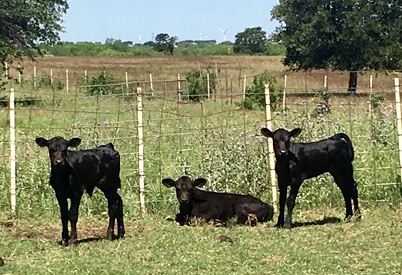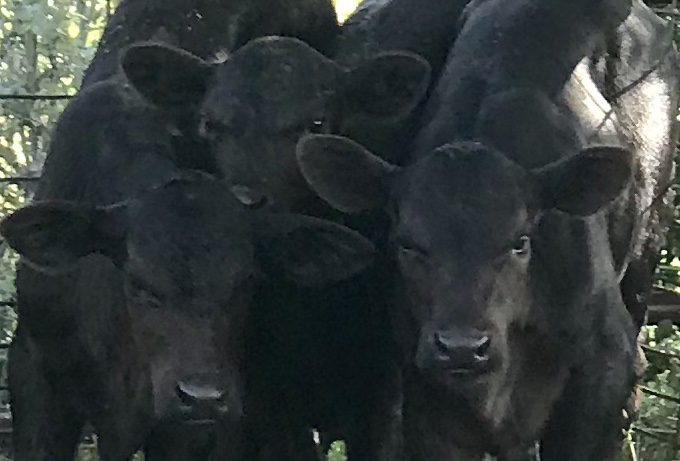Farm & Ranch
Heifer gives birth to triplets in Young County


A heifer from North Texas recently defied the odds when she delivered not one, not two, but three calves earlier this month, an occurrence that happens in only one out of every 100,000 births.
The first-time mom and her triplets, two bulls and one heifer, are reported to be thriving by their owners, Sam Gleaves and his wife, Linda. The pair, along with Christella Jones, run Jones Ranch, located in the small rural community of Farmer, Texas, just 10 miles from Loving in Young County. The ranch contains more than 1,000 acres with 130 cow-calf pairs.
The black Angus heifer is around the age of three and was bred with a half Corriente bull. When she went into labor, the timing just happened to be perfect as Gleaves was just stopping by to check on her and the other cattle.
“The delivery went really good. I just happened to be over there, I try to check them every day, and thought she had twins because there were no other heifers around. We had two sets of twins then already. I didn’t bother her, she was taking care of them,” recalled Gleaves.
The rancher left his new mom alone and returned around 30 minutes later and received the shock of his life when there was a third baby on the ground.
“I thought this can’t be right,” chuckled Gleaves. “But there were four other heifers left and they weren’t even showing they were going to have calves yet, probably only four or five months, no bags or anything. They had to be hers. My wife looked up how rare it is, and it’s unbelievable it happened.”
It would be understandable for a first-time mother of three to be overwhelmed, but so far the triplets are being well taken care of and seem to be flourishing.
“She is a great mother, she takes care of all three of them,” explained the rancher.
To Gleaves’ surprise, the mother had a bit of help from the other cattle shortly giving birth.
“What is funny is when she had that third one, the other four heifers came over and started helping her clean them up. It is like they are sisters or something, they knew she was busy and I’ll be darn if they didn’t come over there. I thought that was really something they helped her out,” said Gleaves.
It was one of the more surprising moments of his ranching career, which started around 18 years ago. The couple first trained horses in Colleyville, when Gleaves’ father-in-law, Bob Jones, offered him a job in the electrical business. Eventually, his in laws bought the Jones Ranch.
“Linda and I decided no one else in the family really wanted to take over the ranch, so when the electrical business sold we moved up here around 18 years ago. It was 500 acres, and no one wanted to mess with cows, so we did and since then the ranch has grown to 1,000 acres with 130 cow calf pairs,” said Gleaves.
His father-in-law has since passed, but Christella Jones, his 86-year-old mother-in-law, lives on the ranch. Born in Farmer with her five sisters, she returns to the roots where she was born.
It is around Jones’ house where the triplets now live, playing and growing under the direction of their mom and two older cows as the ranchers keep an eye on coyotes and any other dangers that might present themselves.
Farm & Ranch
Hazards of Backyard Poultry

By Barry Whitworth, DVM
Having backyard poultry is a popular agriculture enterprise. According to the United States Department of Agriculture, 0.8 percent of all households in the United States have chickens. People keep chickens for a variety of reasons with table eggs being one of the more common reasons.
Unfortunately, some of these poultry producers are not aware of the hazards that come with keeping poultry because many times they carry pathogens but appear healthy.
Chickens are carriers of several zoonotic diseases. These are diseases that can be passed from animals to humans. According to a recent survey in Pennsylvania, a majority of backyard poultry producers were aware of the dangers of avian influenza. However, this study also revealed that far fewer producers were aware of the risk of possible exposure to Salmonella and Campylobacter.
The lack of knowledge about the hazards of raising poultry likely contributes to the continued issues of Salmonella outbreaks associated with backyard poultry. In 2023, the Centers for Disease Control and Prevention reported 1,072 illnesses of Salmonella linked to backyard poultry, and 272 of those patients required hospitalization. Oklahoma reported 43 individuals with the disease.
To read more, pick up a copy of the April issue of NTFR magazine. To subscribe by mail, call 940-872-5922.
Farm & Ranch
Ag Elsewhere: Wyoming

By Tressa Lawrence
Babies are tucked away in every nook and cranny. Many ranchers across Wyoming have baby animals popping up all over this time of year.
Farm & Ranch
Ag Elsewhere: Montana

By Lindsey Monk
Another load of grain in to keep feeding the calves until the green grass can really start popping.
-

 Country Lifestyles1 year ago
Country Lifestyles1 year agoScott & Stacey Schumacher: A Growth Mindset
-

 Equine7 months ago
Equine7 months agoThe Will to Win
-

 Country Lifestyles7 years ago
Country Lifestyles7 years agoStyle Your Profile – What your style cowboy hat says about you and new trends in 2017
-

 Country Lifestyles4 years ago
Country Lifestyles4 years agoAmber Crawford, Breakaway Roper
-

 HOME7 years ago
HOME7 years agoGrazing North Texas – Wilman Lovegrass
-

 Country Lifestyles7 years ago
Country Lifestyles7 years agoDecember 2016 Profile, Rusty Riddle – The Riddle Way
-

 Country Lifestyles8 years ago
Country Lifestyles8 years agoJune 2016 Profile – The man behind the mic: Bob Tallman
-

 Outdoor9 years ago
Outdoor9 years agoButtercup or Primrose?






